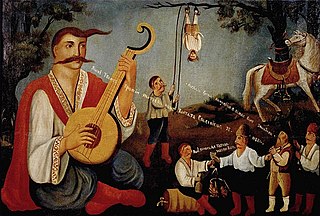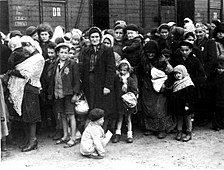
A pogrom is a violent riot incited with the aim of massacring or expelling an ethnic or religious group, particularly Jews. The term entered the English language from Russian to describe 19th- and 20th-century attacks on Jews in the Russian Empire. Similar attacks against Jews which also occurred at other times and places became known retrospectively as pogroms. Sometimes the word is used to describe publicly sanctioned purgative attacks against non-Jewish groups. The characteristics of a pogrom vary widely, depending on the specific incident, at times leading to, or culminating in, massacres.
The Kingdom of Romania, under the rule of King Carol II, was initially a neutral country in World War II. However, Fascist political forces, especially the Iron Guard, rose in popularity and power, urging an alliance with Nazi Germany and its allies. As the military fortunes of Romania's two main guarantors of territorial integrity—France and Britain—crumbled in the Fall of France, the government of Romania turned to Germany in hopes of a similar guarantee, unaware that Germany, in the supplementary protocol to the 1939 Molotov–Ribbentrop Pact, had already granted its blessing to Soviet claims on Romanian territory.

Dorohoi is a city in Botoșani County, Romania, on the right bank of the river Jijia, which broadens into a lake on the north. The city administers three villages: Dealu Mare, Loturi Enescu, and Progresul.

Lipcani is a town in Briceni District, Moldova. It is also a border crossing between Moldova and Romania.

The Odessa massacre was the mass murder of the Jewish population of Odessa and surrounding towns in the Transnistria Governorate during the autumn of 1941 and the winter of 1942 while it was under Romanian control. It was one of the worst massacres in Ukrainian territory.

The Kielce pogrom was an outbreak of violence toward the Jewish community centre's gathering of refugees in the city of Kielce, Poland, on 4 July 1946 by Polish soldiers, police officers, and civilians during which 42 Jews were killed and more than 40 were wounded. Polish courts later sentenced nine of the attackers to death in connection with the crimes.
The history of the Jews in Bessarabia, a historical region in Eastern Europe, dates back hundreds of years.

The Iași pogrom was a series of pogroms launched by governmental forces under Marshal Ion Antonescu in the Romanian city of Iași against its Jewish community, which lasted from 29 June to 6 July 1941. According to Romanian authorities, over 13,266 people, or one third of the Jewish population, were massacred in the pogrom itself or in its aftermath, and many were deported. It was one of the worst pogroms during World War II.

The history of the Jews in Romania concerns the Jews both of Romania and of Romanian origins, from their first mention on what is present-day Romanian territory. Minimal until the 18th century, the size of the Jewish population increased after around 1850, and more especially after the establishment of Greater Romania in the aftermath of World War I. A diverse community, albeit an overwhelmingly urban one, Jews were a target of religious persecution and racism in Romanian society from the late-19th century debate over the "Jewish Question" and the Jewish residents' right to citizenship, to the genocide carried out in the lands of Romania as part of the Holocaust. The latter, coupled with successive waves of aliyah, has accounted for a dramatic decrease in the overall size of Romania's present-day Jewish community.

The history of the Jews in Moldova reaches back to the 1st century BCE, when Roman Jews lived in the cities of the province of Lower Moesia. Bessarabian Jews have been living in the area for some time. Between the 4th-7th centuries CE, Moldova was part of an important trading route between Asia and Europe, and bordered the Khazar Khaganate, where Judaism was the state religion. Prior to the Second World War, violent antisemitic movements across the Bessarabian region badly affected the region's Jewish population. In the 1930s and '40s, under the Romanian governments of Octavian Goga and Ion Antonescu, government-directed pogroms and mass deportations led to the concentration and extermination of Jewish citizens followed, leading to the extermination of between 45,000-60,000 Jews across Bessarabia. The total number of Romanian and Ukrainian Jews who perished in territories under Romanian administration is between 280,000 and 380,000.
The history of the Jews during World War II is almost synonymous with the persecution and murder of Jews which was committed on an unprecedented scale in Europe and European North Africa. The massive scale of the Holocaust which happened during World War II greatly affected the Jewish people and world public opinion, which only understood the dimensions of the Final Solution after the war. The genocide, known as HaShoah in Hebrew, aimed at the elimination of the Jewish people on the European continent. It was a broadly organized operation led by Nazi Germany, in which approximately six million Jews were murdered methodically and with horrifying cruelty. Although the Holocaust was organized by the highest levels of the Nazi German government, the vast majority of Jews murdered were not German, but were instead residents of countries invaded by the Nazis after 1938. Of the approximately 6 million Jews murdered by the Nazis, approximately 160,000 to 180,000 were German Jews. During the Holocaust in occupied Poland, more than one million Jews were murdered in gas chambers of the Auschwitz concentration camp alone. The murder of the Jews of Europe affected Jewish communities in Albania, Austria, Belarus, Belgium, Bosnia & Herzegovina, Channel Islands, Croatia, Czech Republic, Estonia, France, Germany, Greece, Hungary, Italy, Latvia, Libya, Lithuania, Luxembourg, Moldova, the Netherlands, North Macedonia, Norway, Poland, Romania, Russia, Serbia, Slovakia, and Ukraine.

Between 21 and 23 January 1941, a rebellion of the Iron Guard paramilitary organization, whose members were known as Legionnaires, occurred in Bucharest, Romania. As their privileges were being gradually removed by the Conducător Ion Antonescu, the Legionnaires revolted. During the rebellion and subsequent pogrom, the Iron Guard killed 125 Jews, and 30 soldiers died in the confrontation with the rebels. Following this, the Iron Guard movement was banned and 9,000 of its members were imprisoned.

Antisemitism in Ukraine has been a historical issue in the country, particularly in the twentieth century. The history of the Jewish community of the region dates back to the era when ancient Greek colonies existed in it. A third of the Jews of Europe previously lived in Ukraine between 1791 and 1917, within the Pale of Settlement. The large concentration of Jews in this region historically made them an easy target for anti-Jewish actions and pogroms.

The Holocaust in Ukraine was the systematic mass murder of Jews in the Reichskommissariat Ukraine, the General Government, the Crimean General Government and some areas which were located to the East of Reichskommissariat Ukraine, in the Transnistria Governorate and Bessarabia, Northern Bukovina and the Hertsa region and Carpathian Ruthenia during World War II. The listed areas are currently parts of Ukraine.

The Belostok (Białystok) pogrom occurred between 14–16 June 1906 in Białystok, Poland. During the pogrom between 81 and 88 Jews were killed by soldiers of the Imperial Russian Army, the Black Hundreds and the Chernoe Znamia, and about 80 people were wounded.
Nimereuca is a commune in Soroca District, Moldova. It is composed of two villages, Cerlina and Nimereuca.
Szczuczyn pogrom was the massacre of some 300 Jews in the community of Szczuczyn carried out by its Polish inhabitants in June 1941 after the town was bypassed by the invading German soldiers in the beginning of Operation Barbarossa. The June massacre was stopped by German soldiers.
Pechora was a concentration camp operated by Romania during World War II in the village of Pechora, now in Ukraine. The concentration camp was established on the gated grounds of what had once been a private estate of the Polish noble Potocki family on the banks of the Southern Bug river, which had been converted into a sanatorium for tuberculosis patients after the Russian revolution.
The Jews in Bukovina have been an integral part of their community. Under Austria-Hungary, there was tolerance of Jews and inter-ethnic cooperation.

The Bessarabia Governorate was an administrative unit of Romania during World War II.













